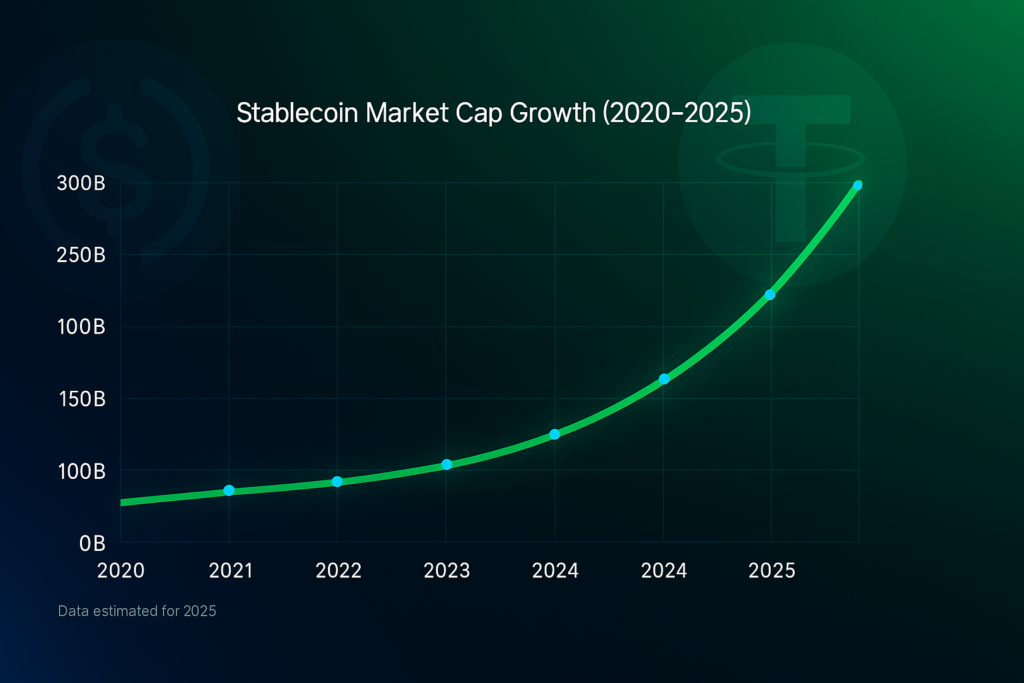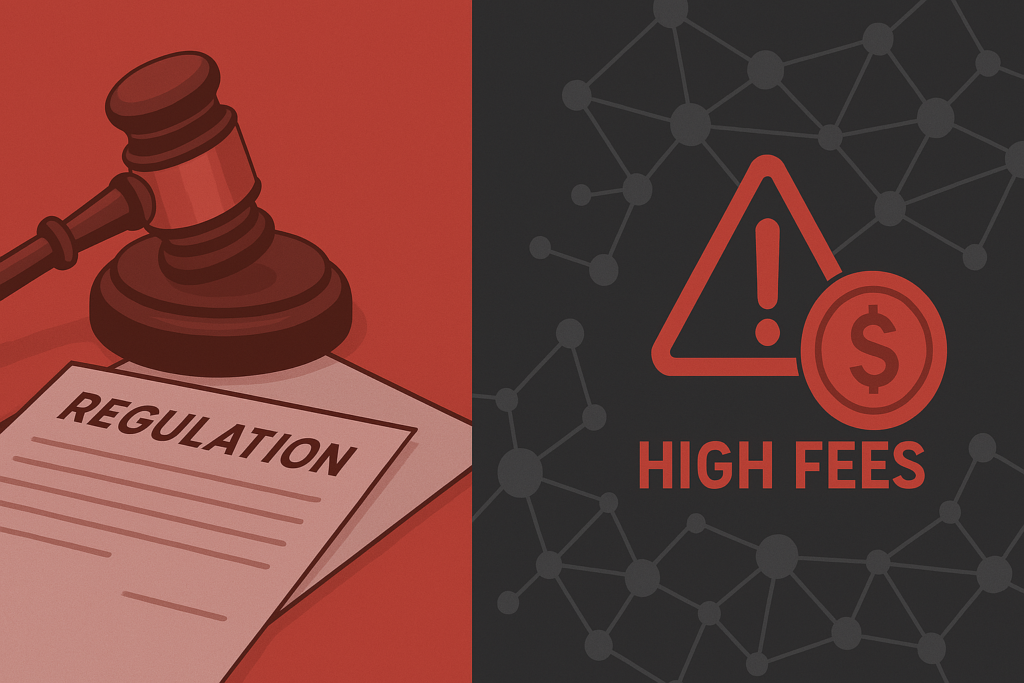– Ad –
| Getting your Trinity Audio player ready... |
The cryptocurrency market has always been a wild ride, with Bitcoin soaring past $100K only to dip to $76K in recent weeks. Amid this volatility, one segment of crypto is quietly stealing the spotlight: stablecoins. Pegged to assets like the U.S. dollar, stablecoins like USDC and Tether offer a haven of stability, and they’re becoming the backbone of a new financial era. In 2025, regulatory clarity and corporate adoption are fueling a stablecoin surge, reshaping crypto’s role in everyday life and paving the way for Web3’s mainstream moment. But what’s driving this shift, and what does it mean for you? Let’s dive in.
The Stablecoin Boom: Why Now?
Stablecoins aren’t new—they’ve been around since Tether launched in 2014. But 2025 is proving to be their breakout year. Unlike Bitcoin or Ethereum, which swing wildly in value, stablecoins are designed to hold steady, making them ideal for payments, savings, and decentralized finance (DeFi). With over 659 million crypto users globally, stablecoins are no longer a niche tool—they’re a necessity.
The catalyst? Two big forces: regulation and corporate buy-in. Globally, governments are now aligning with the cryptocurrency landscape, with stablecoins taking the lead. In the U.S., whispers of a stablecoin bill passing soon have sparked optimism. Meanwhile, the European Union’s MiCA framework has already set clear rules, giving businesses confidence to dive in. On the corporate side, giants like Binance and Circle are doubling down, with partnerships expanding USDC’s reach to millions. Coinbase is creating a stir by incorporating Apple Pay to streamline crypto transactions, a development that signals widespread acceptance.

Regulatory Clarity: A Game-Changer
For years, crypto operated in a gray zone, with regulators eyeing it like a suspicious stranger. That’s changing fast. In the U.S., pro-crypto policies are gaining traction, and stablecoins are leading the charge. A proposed stablecoin law could make them legal tender for financial services, opening the floodgates for adoption. Posts on X buzz with excitement, predicting this could be crypto’s biggest onramp yet.
Globally, the picture is just as bright. The EU’s MiCA rules, fully in effect by 2025, ensure stablecoin issuers meet strict standards, boosting user trust. Countries like Singapore and Hong Kong are also rolling out frameworks, creating a global patchwork of clarity. Why does this matter? Clear rules mean banks, fintechs, and even mom-and-pop shops can use stablecoins without fear of legal backlash. It’s like giving crypto a driver’s license to roam the financial highways.
Also Read: Ripple vs. SEC Ends, Stablecoins Get Green Light: A New Era for U.S. Crypto Policy
Corporate Adoption: Stablecoins Go Mainstream
While regulators lay the groundwork, corporations are building the roads. Binance’s recent move to hold USDC in its treasury is a big deal—it signals that even crypto exchanges trust stablecoins as a store of value. Circle, the issuer of USDC, is pushing hard too, partnering with global platforms to make USDC a go-to for payments. Imagine paying for your coffee with USDC via Apple Pay—thanks to Coinbase’s latest integrations, that’s not far off.
Merchants are jumping on board too. Triple-A, a crypto payment provider, now lets businesses accept USDC seamlessly, cutting out hefty bank fees. For small businesses, this is a lifeline—cross-border payments that once took days now settle instantly. Stablecoins are also powering DeFi, where users earn yields by lending or staking. With 53.5 million people already in DeFi, stablecoins are the fuel keeping this engine running.

Stablecoins and Web3: The Bigger Picture
Stablecoins aren’t just about paying for stuff—they’re the key to Web3’s promise. Web3, the decentralized internet built on blockchain, thrives on seamless transactions. Whether it’s buying NFTs, playing Web3 games like Axie Infinity, or tokenizing real-world assets (think real estate on the blockchain), stablecoins make it happen. In 2025, tokenization is trending, with predictions that trillions in assets could go on-chain. Stablecoins, with their reliability, are the glue holding this vision together.
For the 1.4 billion unbanked worldwide, stablecoins offer a way into the financial system. No bank account? No problem. With just a smartphone and a stablecoin wallet, you can store, transfer, or use funds. In places like Africa and Southeast Asia, where mobile penetration is high, Web3 banking powered by stablecoins is already taking root. It’s financial inclusion on steroids, and it’s happening now.
Challenges on the Horizon
Of course, it’s not all smooth sailing. Regulatory clarity is great, but overreach could stifle innovation. Ukraine’s proposed 18% crypto tax has raised eyebrows, and similar moves elsewhere could dampen enthusiasm. Then there’s market risk—Tether dominates with over 50% of the stablecoin market, raising concerns about centralization. If one player stumbles, the ripple effects could be huge.
Technical hurdles persist too. Blockchain networks like Ethereum still face high fees during peak times, though Layer-2 solutions like Arbitrum are easing the pain. And let’s not forget public perception—crypto’s wild swings make some folks nervous, even if stablecoins are immune. Convincing the average person to trust a digital dollar takes time.

What’s Next for Stablecoins?
So, where do stablecoins go from here? If 2025’s trends hold, they’ll be everywhere—your wallet, your payroll, your favorite game. Regulatory clarity will keep drawing in banks and fintechs, while corporate adoption will make stablecoins as common as PayPal. Web3’s growth, from gaming to tokenized assets, will lean heavily on their stability.
But challenges loom. Balancing regulation with innovation is tricky, and market shocks could test stablecoin resilience. Still, the trajectory is clear: stablecoins are crypto’s bridge to the real world. For investors, they’re a safe bet in a stormy market. For businesses, they’re a cheaper, faster way to move money. And for users, they’re a ticket to financial freedom.
Conclusion: Join the Stablecoin Wave
Stablecoins are no longer crypto’s sidekick—they’re the star of the show. With regulations paving the way and corporations jumping in, 2025 could be the year they go fully mainstream. Whether you’re an investor eyeing DeFi yields, a business owner slashing payment costs, or someone curious about Web3, stablecoins are worth watching. Dip your toes in—try a wallet, explore a DeFi app, or just follow the news. The future of finance is stable, and it’s here.

















